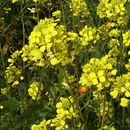The seeds of White Mustard (
Sinapis alba) are an ingredient in table mustard. Since the 1950s, table mustard has also included seeds of Brown or Indian Mustard,
Brassica juncea (prior to this, the seeds of Black Mustard,
B. nigra, were mixed with those of White Mustard in table mustard). The mustard oil from crushed White Mustard seeds contains mainly the essential oil p-hydroxybenzyl isothiocyanate, whereas that from Brown Mustard seeds contains
allyl isothiocyanate. These essential oils, which are derived from
glucosinolates in chemical reactions catalyzed by enzymes known as
myrosinases, are responsible for the "hotness" of mustard. The fact that White Mustard seed oil is relatively mild is due to its lack of allyl isothiocyanate. Rask et al. (2000) reviewed the biochemistry of the glucosinolate-myrosinase system, which is believed to be important in defending the plant from herbivore insects (and possibly from pathogens). Like other mustard family (Brassicaceae) plants, these mustards have flowers with four petals arranged in a cross and pod-like fruits. The fruits of
S. alba are bristly and hairy with a sabre-like beak. (Vaughan and Geissler 1997)
Sinapis alba has been the subject of diverse investigations in plant physiology.

